Rails Service Objects in Ruby on Rails are the least-discussed topic. From Ruby Gems and Rails migrations to action controllers and Ruby metaprogramming, the framework has everything for creating quick prototypes.
So you start loading features into your modules and controllers, and before you know it, they get overloaded to the point where you can’t fit business logic.
This is where Rails service objects help you separate business logic into different Ruby action objects.
This article will discuss the importance of Rails service objects; how they help you develop streamlined products, and how you can effectively fine-tune your Rails applications with this functionality.
What Are Service Objects In Rails?
If you are a Ruby developer, then you might have heard the word “Plain Old Rails Objects” (PORO), and it’s just a method of encapsulating a part of logic that returns a predictable response and is designed to execute one single task.
It encapsulates one functionality, executes one service, and provides a single point of failure. When used in different parts of the application, it reduces code redundancy in the program for better code structure.
These Rails service objects must possess the following characteristics:
>> Initialization method
>> Single public method
>> Returning a predictable >>response after execution
Let’s consider one example where we will create a book instance for our imaginary library app, so the code will look like this.

Considering Ruby’s simplicity, the code looks modular and clean, but let’s not forget that as the app grows, more functionalities will be loaded on the program, which means the code might get dirty and might probably look like the below image.
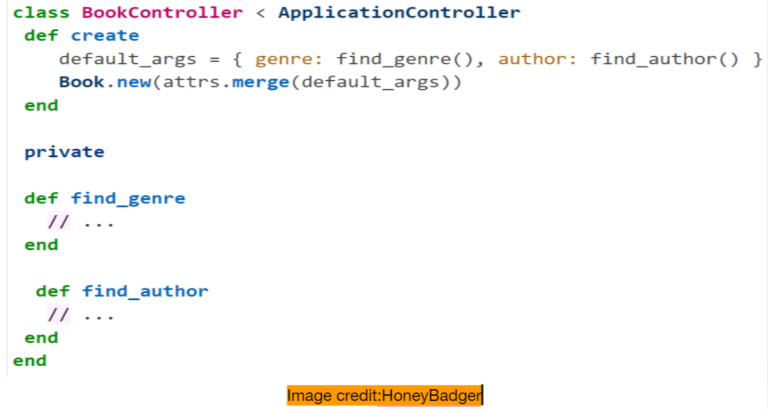
This is where Rails service objects come in, separating this part of the code into classes, causing your code to shrink and clear.

Why are Rails Service Objects Required?
The Rails application takes a straightforward approach, as it was natively designed to support MVC (model view controller) for organizational structure.
This works out for small to medium-sized applications that do not need any extended scalability. However, keeping and managing each element across the models and controllers becomes difficult for an application that requires high scalability with tons of plugins, features, and functionality, as well as extended business logic. Although, if your hire RoR experts, you’ll be ensuring the great leverage of this framework for your project development.
The program codes may get constantly updated, creating junk files not belonging to either the models or the controller. So they are difficult to reuse and maintain at the same time.
Rails Service Objects is a pattern that allows you to separate business logic and other elements from controllers and models, allowing the models to be data layers and the controller to be the API entry point. You will need to use Ruby on Rails API if you want to add more functionality to your services. Most of the services you use on a regular basis use some third-party API to enhance their functionality.
The service objects let you decouple the application logic from your controller. So you can use them separately and reuse them in different parts of your application.
Looking for RoR developers? Find out how to hire Ruby on Rails developers at a reasonable price.
Benefits of Rails Service Objects
Clean Rails Controller
The controller only exists to understand the sent request and turn those requests into parameters, cookies, and objects into arguments that are later passed to the service object to act. Depending on the service response, the controller redirects the renders.
Even if it’s a large-scale enterprise application, the action of controllers using object service does not exceed more than 10 lines of code.
Easy Testing
The separation of your business logic service objects makes it easy to test your service objects and controllers separately.
Do you know RubyMine is one of the best Ruby IDEs for providing support for code refracting, debugging, and unit testing?
Isolated Testing of Business Operations
Since services are compact Ruby objects that have been cut off from their surroundings, they are easily testable. We can track all collaborators easily, and we only need to verify the specific tasks that are carried out within our service.
Re-usable Service objects
A service object can be called from application controllers, background processes, other service objects, etc. Even when you need to perform the same action you can call the service object that can serve you instantly.
Dissociation of Business Domain and Frameworks
The Rails controllers look only at service objects and communicate with the domain objects using those service objects.
This reduction in coupling makes scalability achievable and easy especially when you move from a monolith to a microservice. The services can easily be extracted and moved to new services with the least modifications.
Related Post: Which Ruby Interpreter and Runtime Should You Use?
How to Fine-Tune Rails Application?
Now we will be going through the steps of fine-tuning your rails application, for this, we have picked up the previous example of book library management to show you how it can be done.
Create Service Object
Let’s move ahead and create a BookCreator in a fresh new folder called app/services for your imaginary library managing app
$ mkdir app/services && touch app/services/book_creator.rb
And now insert the business logic into Ruby Class
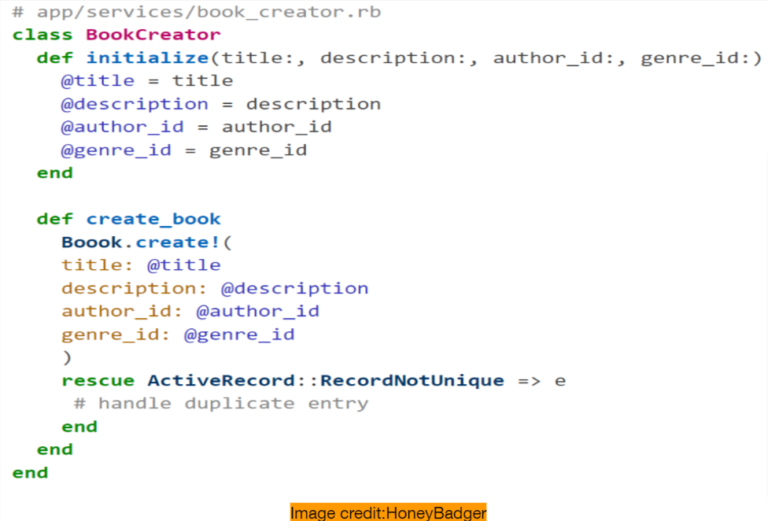
Now here we can call the service objects whether in the controller or anywhere within the program

The Syntax Sugar of Service Objects
Let’s bring some simplification to the BookCreator.new(arguments).create chain using the class method that represents BookCreator and calls the create method
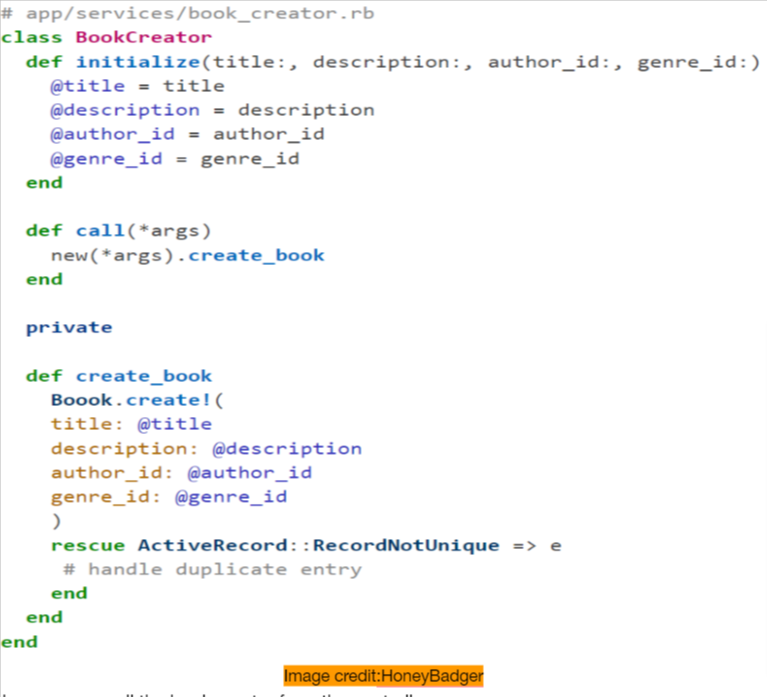
Now you can call the book creator from the controller

To implement the Don’t Repeat Yourself (DRY) principle and reuse the codes with other parts of services objects we have to abstract the call method to a base ApplicationService so every service object can inherit from
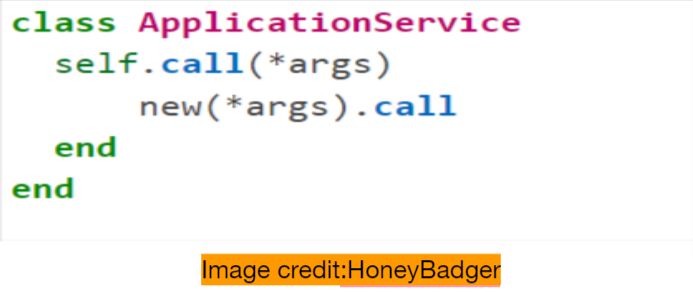
Using above code, we can refactor the BookCreator to inherit from the ApplicationService:
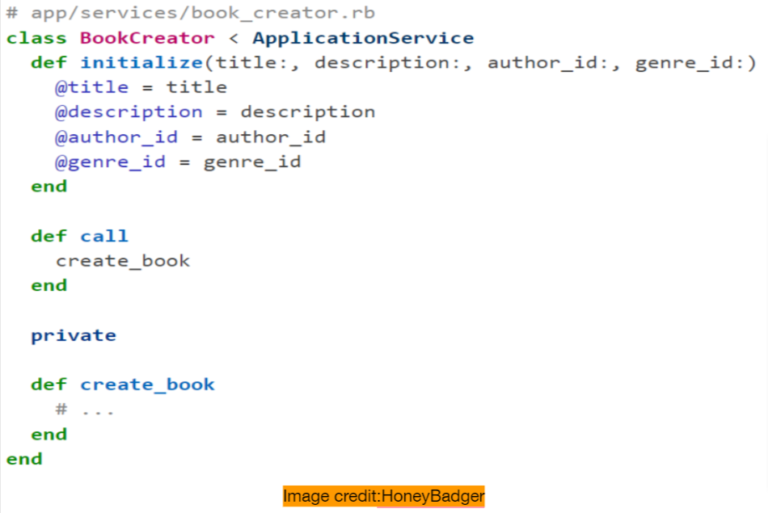
Use Business Process Gems For Creating Service Objects
Using the Rails service objects gem like BusinessProcess, there is no need of creating the base applications service class or defining the initialize the because the gems have built-in configurations. Because the service object has to inherit from the BusinessProcess:: Base.
Add the following gem file,
Gem ‘business_process’
Next, you have to run the bundle command

How to Create Good Service Objects?
Use One Public Method
One object service should perform one business action and do it well so it should expose one public method for that operation and must be kept as a private method. You can keep the name of the public method as you prefer according to other service objects. For instance, we have used call. And other names like execute and perform.
Name Rails Service Objects’ On Their Roles
The name of a service object should imply its objectives. These service objects are named specifically with words that have ending with “or” and “er”.
For example, name the job service object “BookCreator”, and if the task is different like reading a book, name it BookReader.
Avoid Representing Service Objects Directly
You can use syntactic sugar service object pattern or gem like BusinessProcess to trim the inscription of calling service objects.
This way you simplify BookCreator.new(*args).call or BookCreator.new.call(*args) into BookCreator.call(*args), which is quicker and more legible.
Include Service Objects in Ruby on Rails Namespaces
It means nothing but you will be introducing multiple service objects when you are growing an application on a large scale. To enhance code structuring use the practice of code organization, for grouping common service objects in Ruby on Rails namespaces.
Like we have done in the library application, grouping all book-related services jointly and grouping all author-related services in a different namespace. So its folder structure looks like this,
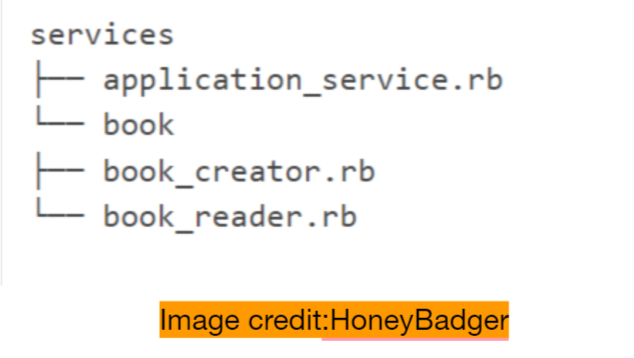
And for the service objects,
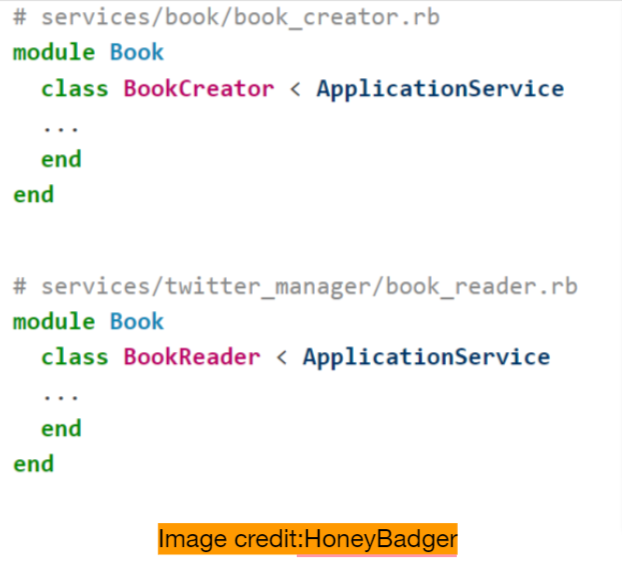
So the call gets,
Book::BookCreator.call(*args) and Book::BookReader.call(*args).
Follow One Service One Task Principle
Having functional service objects on Rails that multitasks opposes the “business action” philosophy of service objects. Conventionally, a generic service that multitasks is not appreciated. So if you are in need to share code between service objects, you can create a base or helper module and use mixins to maintain your service objects.
Use Rescue Exception and Raise Custom Exception
Service objects were created to encapsulate the info inside it, such as communication between different third-party services or libraries or database manipulation with Rails ActiveRecord. If there is a blunder, like ActiveRecord::RecordNotUnique, while communicating with an ActiveRecord, the exception needs to be rescued properly. Errors must be stopped from going up the Rails service call stack. If you fail to handle it within the rescue block, raise a custom-defined exception specific to that service object and resolve the issue.
Related Post: Best Ruby Frameworks for Web Development and Business Growth in 2023
Conclusion
Even though the Rails Service Objects in Ruby on Rails are the least discussed topics, it is the best method for covering up your mess while building large-scale solutions. You can hire RoR Developers to make the best use of Rails Service Objects.
Especially if you load tons of features into your modules and controllers and find yourself in a situation where you can’t fit business logic.
And this is where functional service objects on Rails help you separate business logic into different Ruby action objects for greatly improving the performance of your programs and bringing easy maintainability, testing, and more expressiveness.
Using the above example you can fine-tune your Rails application and get insights into how you can build good service objects.







